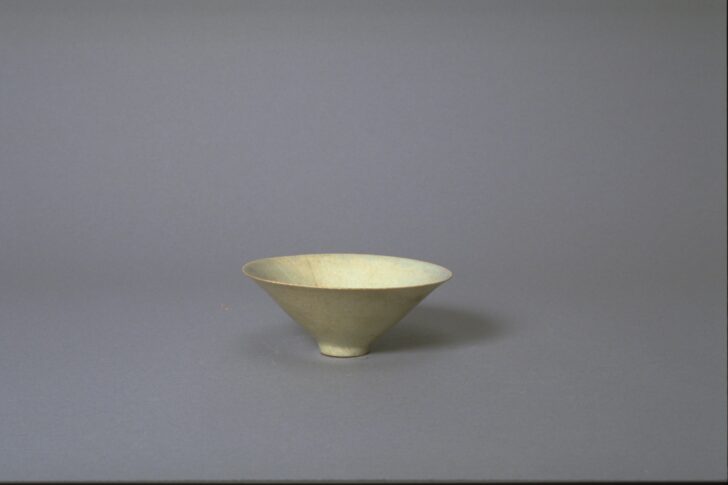Bowl
Chinese

Description
From the eighth century on, tea drinking was firmly established as an important Chinese social custom. The tea was taken in the form of a powder that was whisked into a frothy brew with hot water in elegant conical ceramic bowl. Initially, white wares from Yue, Xing, and Ding kilns were favored. but later black tea bowls from Jian, Cizhou, Jizhou, and Ding kilns became the color of choice.
Song society, lead by cultured emperors like Huizong (r. 1101-26) and Gaozong (r.1127-63), did not seek power and empire like the previous dynasty of Tang, but instead sought learning and contemplation surrounded by refined and elegant daily objects. The pottery industry responded by producing immaculate white wares that could replace silver as luxury tableware. By the eleventh century, Ding had become firmly established as the great white ware of the north, just as the great white ware of the south, qingbai (“clear-white”) ware was getting started at the kilns of Jingdezhen in Jiangsu province. Chinese connoisseurs of the time praised the color and feel of qingbai tea bowls as being like “icy jade” and the ware went on to make Jingdezhen the porcelain capital of the world from the tenth to fourteenth centuries.
(Label for UMMA Chinese Gallery Opening Rotation, March 2009)
Subject Matter:
This is a Qingbai 青白 (literally “bluish white”) teabowl of the Northern Song dynasty (960-1127).
From the eighth century on, tea drinking was firmly established as an important Chinese social custom. The tea was taken in the form of a powder that was whisked into a frothy brew with hot water in elegant conical ceramic bowls. Initially, white wares from Yue, Xing, and Ding kilns were favored, but later black tea bowls from Jian became the color of choice.
Qingbai wares, which consisted primarily of tea bowls, were produced in southern China during the Song dynasty (960-1279) at Jingdezhen, Jiangxi in imitation of northern Ding porcelains. A reduction atmosphere in the Jingdezhen kilns and a high kaolin and low iron content in the clay result in the pale blue cast to Qingbai wares.
Song society, lead by cultured emperors like Huizong (r. 1101-26) and Gaozong (r.1127-63), did not seek power and empire like the previous Tang dynasty, but instead sought learning and contemplation surrounded by refined and elegant daily objects. The pottery industry responded by producing immaculate white wares that could replace silver as luxury tableware. By the eleventh century, Ding had become firmly established as the great white ware of the north, just as the great white ware of the south, qingbai ware was started being produced at the kilns of Jingdezhen in Jiangxi province. Chinese connoisseurs of the time praised the color and feel of qingbai tea bowls as being like “icy jade” and the ware went on to make Jingdezhen the porcelain capital of the world from the tenth to fourteenth centuries.
Physical Description:
This thin porcelain conical bowl has a direct slightly everted rim on a footring. Its interior has a lightly incised floral meander decoration,and it is covered in a white glaze with bluish tinge.
Usage Rights:
If you are interested in using an image for a publication, please visit https://umma.umich.edu/request-image/ for more information and to fill out the online Image Rights and Reproductions Request Form.